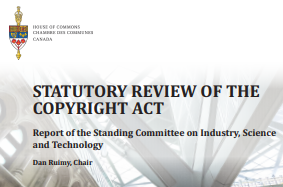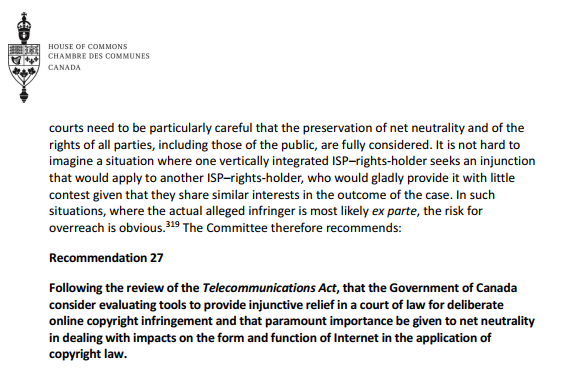Canadian Copyright Review Rejects Site-Blocking Regime, Keeps Safe Harbors

After dozens of hearings, where it heard hundreds of witnesses and reviewed input from various stakeholders, the final review is now ready and published in public.
In a detailed report spanning 182 pages, the Committee issues 36 recommendations, covering a wide range of copyright issues. Interestingly, the first suggestion from the Committee is to remove the mandatory five-year review, which it just completed.
Through various hearings and briefs, many rightsholders stressed that stronger copyright protections are required to deal with online piracy. This includes regular pirate sites but covers also copyright-infringing material uploaded to sites such as YouTube and Facebook.
Several stakeholders, including the Motion Picture Association-Canada, argued that ‘content filters’ would be appropriate. This is comparable to the requirement put forward in Article 17 of the EU Copyright Directive, which may result in ‘upload filters.’
Related proposals suggested narrowing the ‘safe harbor’ for online service providers (OSPs). This includes changes to sections 31.1 and 41.27 of the Copyright Act, including abolishing these altogether.
While the Committee acknowledged the “value gap” problem for rightsholders, it stresses that the rights of Internet users should be taken into account as well.
“[P]roposed amendments to sections 31.1 and 41.27 of the Act would be too blunt a solution to address the issue, especially since there is no consensus among stakeholders about which OSPs cause problems and why. Subjecting OSPs to increased regulations should also reflect a balanced approach,” the report reads.
The Committee finds it questionable, for example, that online services would be required to take down or de-monetize content, without allowing the uploader to respond to allegations of copyright infringement. That appears to refer, indirectly, to the EU’s Article 17.
Instead of making any concrete suggestions, the Committee recommends keeping an eye on how the EU deals with this issue, and draw lessons from this approach. Ultimately, however, any changes should be in the best interests of all Canadians, which is summarized in two recommendations.
“Recommendation 21: That the Government of Canada monitor the implementation, in other jurisdictions, of extended collective licensing as well as legislation making safe harbour exceptions available to online service providers conditional to measures taken against copyright infringement on their platforms.”
“Recommendation 22 That the Government of Canada assert that the content management systems employed by online service providers subject to safe harbour exceptions must reflect the rights of rights-holders and users alike.”
Moving onto enforcement against traditional pirate sites, the Committee reviewed input from various stakeholders who suggested the introduction of a site-blocking regime.
“The fight against piracy should focus more on large-scale, commercial infringers, and less on individual Canadians who may or may not understand that they are engaged in infringement,” the Committee notes, adding that it sees value in pirate site blocking.
To this end, the Telecommunications Act could be revised to streamline the blocking process. However, creating a separate regime that would bypass the courts, as several rightsholders have suggested, goes too far.
“It is for the courts to adjudicate whether a given use constitutes copyright infringement and to issue orders in consequence. The courts already have the expertise necessary to protect the interests of all involved parties,” the Committee writes.
Among other things, a separate regime without oversight would increase the risk of overreach, which could lead to net neutrality violations. The Committee, therefore, suggests that any changes that would simplify site-blocking should keep net neutrality in mind.
“Recommendation 27: Following the review of the Telecommunications Act, that the Government of Canada consider evaluating tools to provide injunctive relief in a court of law for deliberate online copyright infringement and that paramount importance be given to net neutrality in dealing with impacts on the form and function of Internet in the application of copyright law.”

That’s a major disappointment to the Fairplay Coalition, which came up with the site-blocking regime. However, rightsholders did succeed in convincing the Committee that higher statutory damages are needed to deter infringement.
Another piracy-related issue that came up relates to the notice-and-notice scheme. This allows rightsholders to send infringement notices to ISPs, which must be forwarded to subscribers.
ISPs complained that this is very resource intensive, as there is no standard notice format. That also opens the door to abuse, where rightsholders demand settlements from subscribers, even though that’s outlawed. The Committee agrees and recommends standardization of the notices.
“Recommendation 25: That the Government of Canada make regulations to require notices sent under the notice-and-notice regime be in a prescribed machine-readable format.”
The American Registry for Internet Numbers (ARIN) was also heard by the Committee. The organization wants ISPs and other large companies to maintain a Whois database of IPv6 IP-addresses and numbers. This would help to track down copyright infringers.
Such a database is already in place for IPv4 numbers but the Committee recommends expanding this so it covers IPv6 resources as well.
“Recommendation 26: That the Government of Canada examine ways to keep IPv6 address ownership information up-to-date in a publicly accessible format similar in form and function to American Registry for Internet Numbers’ IPv4 ‘WHOIS’ service.”
The last issue we highlight is a proposed limitation to fair dealing for educational use. Several publishers requested this noting that they’re losing revenue, but the Committee believes that a further review is needed before it can make any concrete recommendations.
At the same time, the Committee proposes to expand current fair dealing rights by making the examples which are listed in the Copyright Act illustrative, instead of exhaustive. This would make it easier to classify new types of creative expressions as fair dealing.
All-in-all the review of the Copyright Act provides a mixed bag for all involved. While the recommendations are clear, it is still up to the Canadian government to act on them.
University of Ottawa professor Michael Geist, who has followed the developments closely, describes the report as balanced. However, we expect that many rightsholders had hoped for more.
The Committee makes it clear, however, that their conclusions represent a compromise. Not everyone will agree, but it’s what they have to work with going forward.
“Reviewing the Act is not about deciding who is right between stakeholders, but about capturing as many perspectives as possible to ensure that, on the whole, the resulting recommendations reflect the reality of living together,” the Committee writes.
“This report’s success lies in making stakeholders feel compelled to respond to it with passion, integrity, and rigour –whether or not they agree with its content,” it adds.
–—
A copy of the Statutory Review of the Copyright Act is available here (pdf).
Source: TF, for the latest info on copyright, file-sharing, torrent sites and more. We also have VPN reviews, discounts, offers and coupons.



Leave a Reply
Want to join the discussion?Feel free to contribute!